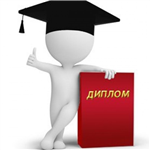Дипломная работа на тему "ТЮМГУ | Непредставимый нарратив: исследование репрезентации в фильмах «Хиросима, моя любовь» (1959) и «Расёмон» (1950) [ID 22743]"
0
Эта работа представлена в следующих категориях:
Работа на тему: Непредставимый нарратив: исследование репрезентации в фильмах «Хиросима, моя любовь» (1959) и «Расёмон» (1950)
Оценка: отлично.
Оригинальность работы на момент публикации 50+% на антиплагиат.ру.
Ниже прилагаю все данные для покупки.
https://studentu24.ru/list/suppliers/Anastasiya1---1326
Оценка: отлично.
Оригинальность работы на момент публикации 50+% на антиплагиат.ру.
Ниже прилагаю все данные для покупки.
https://studentu24.ru/list/suppliers/Anastasiya1---1326
Демо работы
Описание работы
MINISTRY OF SCIENCE AND HIGHER EDUCATION OF RUSSIAN FEDERATIONFederal Autonomous Educational Institution of Higher Professional Education
«UNIVERSITY OF TYUМEN» SCHOOL OF ADVANCED STUDIES
RECOMMENDED DEFENSE IN ЕС FOR А
UNDERGRADUATE THESIS
UNREPRESENТABLE NARRATIVE: ТНЕ STUDY OF REPRESENТATION IN ТНЕ FILMS "HIROSHIMA MON AMOUR" (1959) AND "RASHOMON" (1950) / НЕПРЕДСТАВИJ\1ЫЙ НАРРАТИВ: ИССЛЕДОВАНИЕ РЕПРЕЗЕНТАЦИИ В ФИЛЬМАХ «ХИРОСИJ\1А, МОЯ ЛЮБОВЬ» (1959) И «РАСЁМОН» (1950)
42.03.05 Mediacommunications
«Film and Media Studies»
Tyumen 2023
МИНИСТЕРСТВО НАУКИ И ВЫСШЕГО ОБРАЗОВАНИЯ РОССИЙСКОЙ ФЕДЕРАЦИИ
Федеральное государственное автономное образовательное учреждение высшего образования
«ТЮМЕНСКИЙ ГОСУДАРСТВЕННЫЙ УНИВЕРСИТЕТ» ШКОЛА ПЕРСПЕКТИВНЫХ ИССЛЕДОВАНИЙ (SAS)
РЕКОМЕНДОВАНО К ЗАЩИТЕ В ГЭК
ВЫПУСКНАЯ КВАЛИФИКАЦИОННАЯ РАБОТА
бакалаврская работа
UNREPRESENT ABLE NARRATIVE: ТНЕ STUDY OF REPRESENTАTION IN ТНЕ FILMS "HIROSНIMA MON AMOUR" (1959) AND "RASHOMON" (1950) / НЕПРЕДСТАВИМЫЙ НАРРАТИВ: ИССЛЕДОВАНИЕ РЕПРЕЗЕНТАЦИИ В ФИЛЬМАХ «ХИРОСИМА, МОЯ ЛЮБОВЬ» (1959) И «РАСЁМОН» (1950)
42.03.05 Медиакоммуникации
«Кино и Медиа»
Тюмень 2023
TABLE OF CONTENTS
ABSTRACT 4
PREMISE OF THE WORK 7
CHAPTER 1: THE QUESTION OF REPRESENTATION 13
1.1. THE ESSENCE OF NUCLEAR EXPLOSION 13
1.2. TRAUMATIC EVENT 16
CHAPTER 2: FILM ANALYSIS 19
2.1 INTRODUCTION TO THE CASE STUDIES 19
2.2. HIROSHIMA MON AMOUR 20
2.3. RASHOMON 23
CONCLUSION: THE DETOUR STRATEGY 28
BIBLIOGRAPHY 30
ABSTRACT
This study addresses the issue of representing the complexity of a historical event in a film medium by complicating the representing capacities of technologies along with the notion of traumatic experience. Focusing on one specific historical event—the atomic bombings of Japanese cities, the study interweaves two feature- length films, «Hiroshima mon amour» (1958) and «Rashomon» (1950). Based on the evidence obtained through the film analysis method, I suggest that these films reveal and confront existing historical contradictions with the help of the characters' storylines and formal means, and in this way, present the historical event with more versatility and complexity. Consequently, I identify the strategy that can accurately depict the event with its historical complexity, and I compare it to detours as a method to get around the existing contradictions and at the same time give the most complete picture of the historical event.
INTRODUCTION
The atomic bombing of Hiroshima and Nagasaki are two exceptional cases in human history of the combat use of nuclear weapons. Despite the obvious destructiveness and catastrophic nature, these events left an ambiguous mark in history. On the one hand, many people see the nuclear catastrophe as «momentous in helping to bring WWII to a merciful end» [Sodei, p.1120]. This cultural narrative was deliberately constructed to justify political decisions [Sherwin, p. 1086]. On the other hand, there are the realities endured by the victims of Hiroshima and Nagasaki that complicate and go against the prevalent account of the glorious war ending. The dominant cultural narrative proposes the status quo concerning the nuclear catastrophe and does not allow us to think about it in intrinsic complexity. Thus, the traumatic realities that are at the heart of the events remain untold and hidden. For this reason, the victims and eyewitnesses of the horrific events that took place in Japanese cities in 1945 created the practice of oral stories about their real experiences. These revelations have much in common with oratory. Using various techniques, the narrators are trying not so much to share experience as they seek to shed light on the complexity of the events that happened [Yoneyama, p.92]. Thus, the real picture of these traumatic events involves the interweaving of many different perspectives and points of view and raises the question of irrepresentability.
Speaking about such events one way or another, it is necessary to speculate about their traumatic nature. Trauma history brought by Cathy Caruth proposes that looking at the past through the notion of trauma permits history “to arise where immediate understanding may not" [Caruth, p.11]. The issue of understanding lies in the inherent "latency, the period during which the effects of the experience are not apparent" of the trauma itself [Caruth, p.17]. Thus, trauma becomes a transmitting matter able to complement the history known to us. However, it remains paradoxical since the trauma itself is seen as an inaccessible and unrepresentable phenomenon. How much can an event tell by itself, especially if it is difficult to represent? By shifting the focus directly from the event to the crisis that arose later, we have greater opportunities for analyzing and understanding the essence of the traumatic event. The approach proposes seeing the trauma as an adaptation to a new reality as opposed to a side effect of the traumatic event. Lauren Berlant's critical account suggests a different approach to history that focuses on what happens after the historical event, or what she refers to as the ordinary. She fundamentally changes the approach to the historical perception of trauma: “Trauma, after all, does not make experiencing the historical present impossible but possible: not in the sense that one still has a conventional biography to tell that relates and provides a foundation for self- possessed identity, but in the sense that as trauma shatters the biostory that was a foundation for what gets taken for granted about life’s historical self-continuity, it transforms the the work of survival without much of a normative plot or guarantees.” [Berlant, p.81]. In this way, Berlant expands on the point of view brought by Caruth, her perspective allows us to see that trauma is not an incomprehensible historical resource, but rather an affective structure that influences all further perception of history. This understanding motivates me to pay attention not only to the historical event itself but also to what comes after it. From this point of view, films, as mediums that directly represent things, are an excellent opportunity for such an analysis.
This study attempts to investigate how a film medium represents an unimaginable and incommunicable experience, such as an atomic explosion. Many films attempting to convey this type of traumatic experience rely on clichéd depictions such as the mushroom cloud, which not only fail to capture the essence of the disaster but also serve to reinforce the dominant cultural narrative. I attempt to investigate the ways that film medium enables to use in order to escape the ubiquitous image of the Hiroshima nuclear disaster and create a possibility to extend and critically assess the dominant cultural narrative. For this purpose, I brought together two films: «Rashomon» by A. Kurosawa and «Hiroshima mon amour» by A. Resnais. While «Hiroshima mon amour» directly addresses the case of the Hiroshima and Nagasaki atomic bombings, Rashomon does not directly refer to any historical event; however, researchers do not exclude interpretation of the last mentioned in terms of the historical and cultural context of the time of its creation [Linden, p.403].
Thus, both films can be considered within a single historical context, implying the end of World War II and the atomic bombing of Japanese cities. The results of my research suggest that both films not only evoke the limitations of vision and representation but also allow one to apply this understanding to the particular historical referent. In this way, I identify the strategy capable of depicting the historical complexity of the event. Considering this strategy in comparison with the techniques that survivors use in their storytelling practices, I contend that these films, through the characters' stories, reveal and confront existing contradictions, presenting the event's versatility and complexity. Thus, a specific set of formal elements creates an opportunity to expand the viewer's understanding of the dominant cultural narrative.
BIBLIOGRAPHY
1. Anderst, L. Cinematic Free Indirect Style: Represented Memory in ‘Hiroshima Mon Amour’ // Narrative 19. - 2011. - №3. - P. 358–382.
2. Berlant, L. Cruel Optimism. - Durham: Duke University Press, 2011. - 352 p.
3. Broad, W. The Hiroshima Mushroom Cloud That Wasn’t // The New York Times. - 2016. - 23.05.
4. Caruth, C. Unclaimed experience: Trauma, narrative, and history. - Baltimore: Johns Hopkins University Press, 1996. - 167 p.
5. Chow, R. The Age of the World Target. - Durham: Duke University Press, 2006. - 144 p.
6. Douglass, A., Vogler, T. Witness and Memory: The Discourse of Trauma. - New York: Routledge, 2003. - 228 p.
7. Lifton, R.J. Death in Life: Survivors of Hiroshima. - Carolina: University of North Carolina Press, 1991. - 606 p.
8. Linden, G.W. Five Views Of ‘Rashomon' // Soundings: An Interdisciplinary Journal.
- 1973. - №4. - P. 393–411.
9. Lippit, A.M. Atomic Light (Shadow Optics). - Minneapolis: University of Minnesota Press, 2006. - 224 p.
10. Lowe, D., Atherton C., Miller A. The Unfinished Atomic Bomb: Shadows and Reflections. - Lexington: Lexington Books, 2017. - 220 p.
11. Martin J.S. Hiroshima as Politics and History // The Journal of American History. - 1995. - №82. - P. 1085-1093.
12. Redfern, N. Film Style and Narration in Rashomon // Journal of Japanese and Korean Cinema. - 2013. - №5. - P. 21–36.
13. Sodei, R. Hiroshima/Nagasaki as History and Politics // The Journal of American History. - 1995. - №82. - P. 1118-1123.
14. Walker, J. Trauma Cinema: False Memories and True Experience // Screen. - 2001. - №42. - P. 211–216.
15. Yoneyama, L. Hiroshima Traces: Time, Space, and the Dialectics of Memory.
- Berkeley: University of California Press, 1999. - 314 p.

